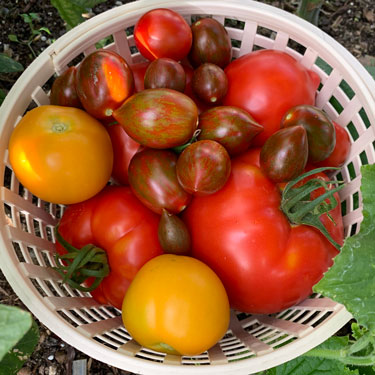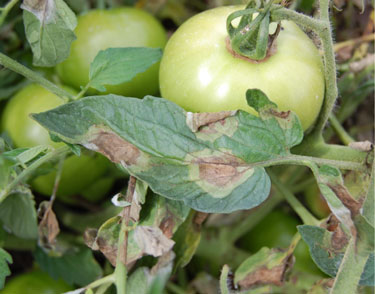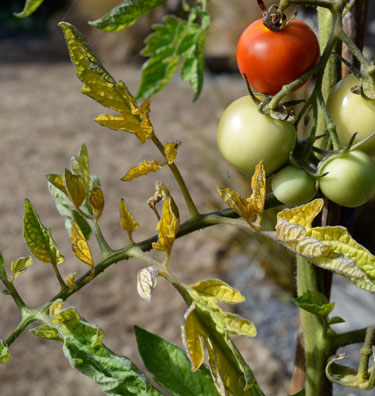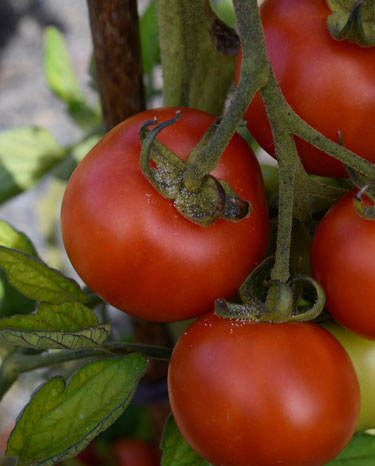Taking care of tomatoes
Tomatoes love summer. Plants popped in the ground in October and November grow strongly in warm weather and the first little fruit are already appearing in some gardens. Keeping up with feeding and watering over the coming months will ensure bumper crops of delicious sun-ripened fruit right through till autumn.
It’s time to be on watch for pesky bugs, as summertime is also party time for pests and diseases. Early blight is a fungal disease which starts by causing distortion of the new growth, followed by brown or black spots. Late blight is caused by a microorganism called Phytophthora which thrives in a warm moist environment. Brown patches appear on the leaves and can spread very fast. When tomato leaves turn yellow and wilt the plant may be under attack from other soil dwelling fungal diseases, usually in cool wet conditions.
Aphids and clouds of tiny whitefly can breed like fury as the weather warms up. But by far the most destructive of the sucking insect pests is the Tomato Potato Psyllid (TPP). The adults look like tiny cicadas, about 3 mm long. Yellowish nymphs appear on the underside of the leaves. Their excreta look like grains of sugar. The worst thing about this sapsucker is that it injects bacteria which severely weaken the plant with significant loss in yield. TPP is hosted by many plants in the tomato family, including weeds, and it also attacks kumara.
Keep an eye out for tomato fruit worm (aka corn worm), a caterpillar that eats holes into fruit, leaving black excreta in its wake. The adult moths feed on nectar and lay eggs by night, hiding away during the day. Pick off any caterpillars and dispose of damaged fruit to prevent population build up.
Despite appearances, some tomato problems are not caused by anything living. Blossom end rot, for example, is the plants response to lack of calcium uptake, usually because of an inconsistent water supply. Dark brown hollow patches form at the base of the fruit.
Watering and feeding goes a long way to keeping tomato plants happy, but keeping bugs at bay takes a multi-pronged approach…
Start with the basics
A healthy, well-fed and well-watered plant has a better chance of fighting off attacks from pests and pathogens than a sickly malnourished one. Tomatoes need a continuous supply of nutrients to support their rapid growth. Soil that’s rich in organic matter ensures water and nutrients are easily accessible to plants.
Water deeply to encourage young roots to grow deeply into the soil where there is a more reliable supply of moisture and nutrients. Apply water directly to the soil. Mulching with a layer of straw or fine bark will help keep the moisture in the soil where it is needed. Sprinklers are best avoided as wet leaf surfaces invite disease.
Avoid humid conditions
Tomato pests and diseases thrive and multiply in damp warm conditions. Keeping stems and leaves dry and well aerated is key. Keep them weed-free with plenty of space for air movement. Too much air movement, on the other hand, isn’t helpful as wind damage is a potential entry point for disease. Tying tall growing tomatoes to a support keeps plants off the ground ensuring plenty of air movement to minimise disease.
Minimise disease spread
Disease spores are moved from one plant to another via tools and fingers. Avoid pruning tomatoes on a wet or humid day as moisture assists disease entry. When lower leaves show signs of disease remove them, ideally with clean sharp tools. Sometimes it may be necessary to remove an entire plant.
Refrain from adding infected material to your home compost heap, which is unlikely to get hot enough to kill all the disease spores and insect eggs. Ideally, avoid planting tomatoes and their relatives (potatoes, capsicum, chilies, eggplants) in the same place year after year. The longer a garden bed has a rest from any one plant family, the better. If it’s too hard to change the planting place, consider changing the soil or planting tomatoes in containers.
Consider crop cover
Mesh crop cover fabric is now available in garden centres and is an effective way to prevent insect pests including psyllids from laying their eggs on crops. It is important that the fabric weave is small enough to block these tiny insects and it needs to be completely sealed around the edges and a tall frame will be needed for tall growing tomato plants. Disadvantages of fabric mesh can be increased humidity and reduced light. It will also block pollinators (not important for tomatoes).
Keep watch and act early
Spraying with the right product at the right time can be the most cost-effective option to save a crop under threat, but to be effective, insect and disease sprays need to be applied before pest and disease populations take hold. Garden centres are a good place to go for help in choosing the right product. Today’s registered home garden pesticides are at the very low end of toxicity and pose no risk to humans when used as directed. Several are also safe to bees once they have dried on the plant. Natural products like neem tree oil and diatomaceous earth powder have been shown to be effective against psyllids when used correctly. Copper provides effective control against fungus disease and is an accepted organic spray option, but its overuse is a concern for soil health.
Try different varieties
Most tomato varieties sold these days have good disease resistance, but how well a particular variety will fear in your garden will depend on climate, soil and location. Working out which are best for your garden is largely a matter of trial and error and sharing success stories among friends and neighbours. Early ripening varieties may provide a good crop before the worst pests and diseases take hold. Grafted tomato plants offer extra vigour and disease resistant roots.
TIPS:
- Plant tomatoes a few cm deeper than they were in their pots to stimulate new feeder roots for extra anchorage and nutrient uptake.
- Plant a diverse selection of varieties known for their disease resistance.
- Tomatoes are self-pollinating. Each tomato flower contains both male and female parts, so when pollen falls within the flower the flower fertilises itself. This is aided by wind movement and bees, but you can increase the odds by giving plants a daily tap or gentle shake.
- Mulch with a layer of straw or fine bark will help keep the moisture in the soil where it is needed.
- When lower leaves show signs of disease remove them to prevent disease spreading to the rest of the plant. Refrain from adding infected material to your home compost heap.

15-Nov-2023

A selection of tomato varieties

Late blight

Symptoms of attack by Tomato Potato Psyllid

'Sugars' caused by Tomato Potato Psyllid

Blossom end rot

